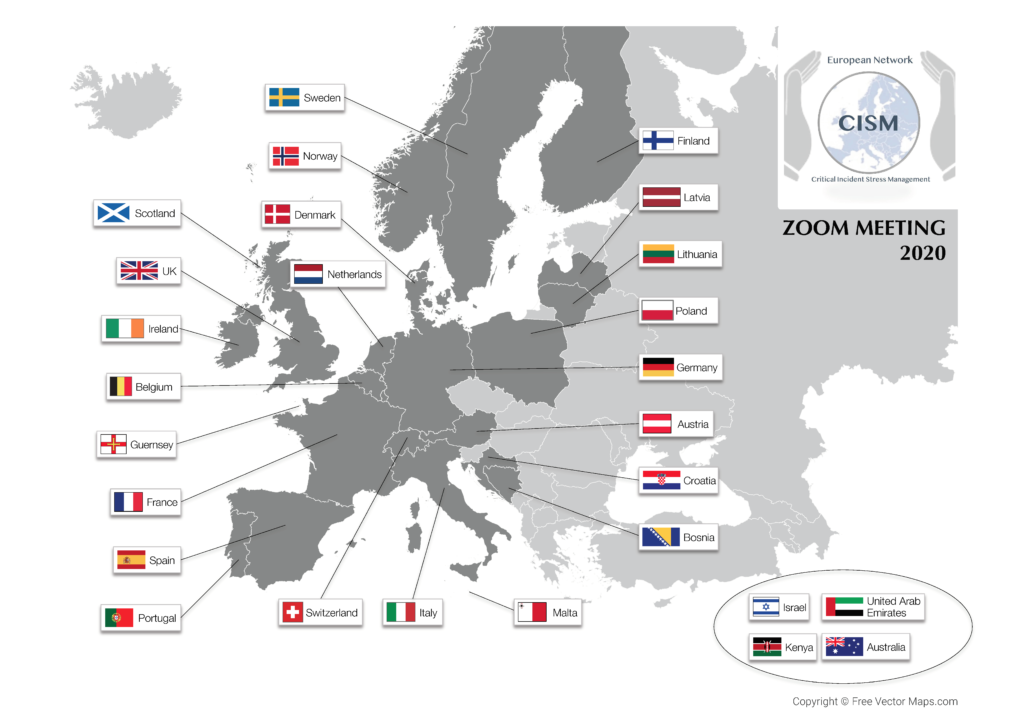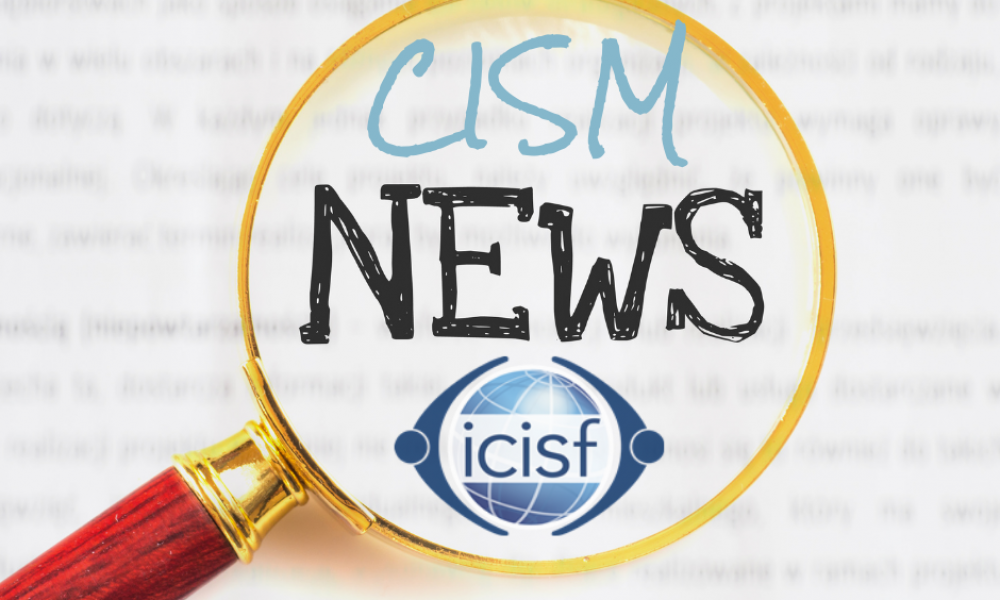CISM Practical Support, Research and Psychological Risk Assessment During COVID-19
By: Dr. John Durkin, Ph.D.
On November 26, 2020 the European Critical Incident Stress Management (CISM) network held its annual conference CISM practical support and research in psychological risk assessment during Covid-19 online. There were 177 delegates from 21 European and four non-European countries registered for the event.

Introduction
After the formal welcome, technical guidance and a view of the map showing the countries delegates were drawn from (see Figure 1.) a formal address was made on behalf of the International Critical Incident Stress Foundation (ICISF). For those delegates having little knowledge of ICISF and its mission the practical nature of CISM was emphasised along with its survival as ‘best-practice’ in many organisations whose work threatens the mental health of its workers. A call was made for continued cooperation and an increase in research and data-collection to gather evidence in support of crisis intervention. The history of CISM in Europe put the conference in context with a forward-looking perspective.
Presentations and Speakers
Dr John Durkin
John is a board member of ICISF and psychologist specialising in posttraumatic growth. He moved to Australia in 2019 and maintained his links with European colleagues to promote research amongst the various sectors represented in the network.
Psychological risk assessment of medical staff affected by Covid-19 in Victoria, Australia
As a former-firefighter John imagines teaching firefighters whenever he speaks to an audience and so looks for ways to turn complicated information into a simple story or procedure. He took the example of Covid-related stress in a hospital in Victoria, Australia and looked at it through the legal demands of health, safety and risk assessment, in this case for mental health. The three steps in a risk assessment are to:
- identify the hazard,
- intervene to eliminate or minimize the hazard, and
- monitor the effect of the intervention.
John’s risk assessment approach to mental health lies in an online portal for staff to complete clinical questionnaires measuring ‘hazards’ such as depression and burnout. An e-mail to the completer reports a risk level of high, medium or low. A high score would be coloured ‘red’, to indicate a hazard. Then all the scores from all the e-mails are de-identified and placed in a spreadsheet for analysis. If 100 e-mails are sent, 100 rows of scores appear in the spreadsheet. Any e-mail with a ‘red’ score reminds the completer of their responsibility to act to reduce the hazard. The spreadsheet informs the organisation of the teams or departments reporting most hazards and reminds them also of their responsibility to act. Once action is taken the portal can be completed a short time later to meet Step 3, to monitor the effect of the action taken. This way of assessing risk shares legal responsibility between the individual worker and the organisations managers. The worker is responsible for their own mental health and the organisation is responsible for the workplace environment.
…………………………..
Supporting front line operators during COVID-19 March to May period with online support network
Gianluca Carpino
Gianluca is an airline pilot, aviation accident Investigator and prosecution expert. He coordinates the MaydayItalia peer support group and delivers Emergency Response Plan training and auditing for airport and airlines’ operators. He is committed to safety in crisis and accident management and the promotion of peer support and CISM.
During the first pandemic spike in Italy in March and April, MaydayItalia initiated an online support system for peers to connect with and to share between them. As this early approach grew in scale wider actions were taken, including the development of an online support system to meet the needs of frontline doctors and nurses in the hospital. The network linked experienced peers with ‘novices’ with supervision from psychologists. Support was delivered online using the Zoom platform and supplemented by information on issues including Covid-related stress and self-care.
…………………………..
How the Wellbeing Programme evolved in the COVID environment for Airline and Emergency Operators (Gianluca Carpino)
The economic downturn caused by Covid-19 evolved into a serious crisis for airlines. With aircrew being so badly affected a new approach was taken to enhance resilience and reduce or overcome the negative emotional and professional effects of the pandemic. The new approach included the training of peers who were prepared to draw attention to the importance of creating a well-being ethos with a fellow crew member.
…………………………..
Peer support to Hospital staff at the Swedish intensive care units during COVID-19. Lessons learned during a dynamic crisis
Per Hassling
Per Hassling worked as a firefighter, paramedic and dispatcher at the Greater Goteborg Fire and Rescue Service for 20 years and is now a Human Resources specialist. He founded a support group for colleagues in search-and-rescue in Gothenburg City that was later involved in the aftermath of the discotheque fire in Gothenburg in 1998 where 63 young people died. His involvement was recognized by an award at the ICISF World Congress in 1999. He is an active trainer and consultant for emergency, military and police organisations and a founding member of the European CISM network.
Stefan Dahlberg
Stefan is the leader of Competenscompagniet a network organization of 120 members. He has a background in forensic psychiatry, teaching in the Swedish Air Force and the Stockholm Police. He helped establish the crisis intervention program for military personnel returning from deployment to war zones including from Bosnia, Kosovo, Afghanistan, Congo, Liberia and Lebanon. He teaches crisis management at Stockholm University, and led responses during the tsunami in Thailand and to terrorist incidents in Sweden and with Swedish nationals overseas. He is the author of several crisis management books and manuals.
The distinction was made between a ‘static’ and a ‘dynamic’ crisis. A static crisis is a critical incident that is complete and where no operational threat remains. A dynamic crisis is a critical incident (or incidents) that is ongoing or incomplete with an evolving character that changes in intensity until the entire incident is over. Adapting interventions to maintain support throughout a dynamic crisis requires cooperation between peers and mental health professionals despite different backgrounds and attitudes.
The different backgrounds and attitudes can be seen in the metaphor of ‘outdoor cats’ referring to peers drawn from emergency and medical occupations and ‘indoor cats’ referring to professionals from health departments. Indoor cats can be identified by their familiarity with challenging, rapidly evolving life-and-death situations and trying to bring control to chaotic situations. Outdoor cats can be identified by their familiarity with theory, structure and procedure. In dynamic crisis situations it is necessary to be able to both organize and improvise and to handle the problems of professional defensiveness likely when challenged by one of the ‘other’ cats.
Examples managing dynamic crises including work in Thailand during the 2004/2005 tsunami and at Nordic Airports when passengers were evacuated. The current Covid-19 crisis is obviously a dynamic one where the risk of being infected by those with the virus, infecting others (especially colleagues, patients and family members) creates numerous problems and tensions that do not exist in static situations. Reviews, supporting the supporters and periodic evaluations were all welcome contributions to the Covid-19 crisis amongst hospital staff.
Acknowledgements
The organising committee comprised Claudine Mayer-Sager (Switzerland), Paul Johannessen (Norway), Stefan Dahlberg (Sweden), Per Hassling (Sweden) and Richard Friedrich (Guernsey, UK). The number of delegates far exceeded the committee’s expectations so Madelene Segertoft is acknowledged for the excellent support and technical expertise she applied to ensure the smooth-running of the event. This event grew from a lunch meeting in Baltimore in 2015 during which Stefan, Per and Johara Boukaa committed themselves to the establishment of CISM in their respective countries and occupations. This conference is evidence that their commitment was well-directed with the future of CISM in Europe looking stronger than ever.
The 2021 European CISM Network conference is being organised for October 14 and 15 to be held in Lucerne, Switzerland.

